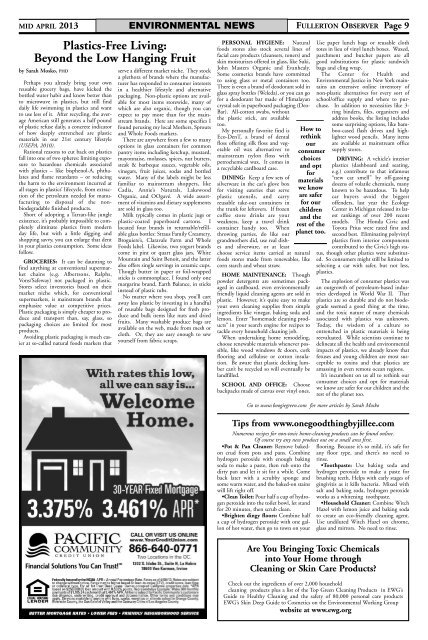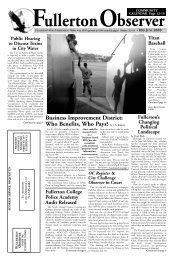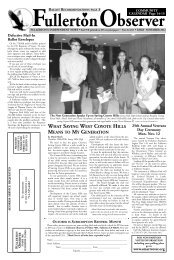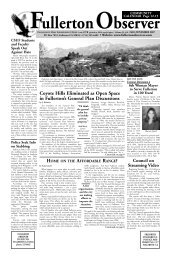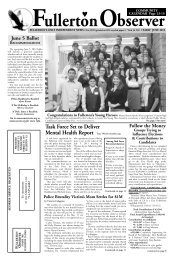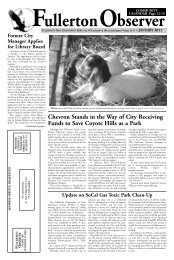Create successful ePaper yourself
Turn your PDF publications into a flip-book with our unique Google optimized e-Paper software.
MID APRIL 2013<br />
by Sarah Mosko, PHD<br />
Perhaps you already bring your own<br />
reusable grocery bags, have kicked the<br />
bottled water habit and know better than<br />
to microwave in plastics, but still find<br />
daily life swimming in plastics and want<br />
to use less of it. After recycling, the average<br />
American still generates a half pound<br />
of plastic refuse daily, a concrete indicator<br />
of how deeply entrenched are plastic<br />
materials in our 21st century lifestyle<br />
(USEPA, 2010).<br />
Rational reasons to cut back on plastics<br />
fall into one of two spheres: limiting exposure<br />
to hazardous chemicals associated<br />
with plastics – like bisphenol-A, phthalates<br />
and flame retardants – or reducing<br />
the harm to the environment incurred at<br />
all stages in plastics’ lifecycle, from extraction<br />
of the petroleum needed for manufacturing<br />
to disposal of the nonbiodegradable<br />
finished products.<br />
Short of adopting a Tarzan-like jungle<br />
existence, it’s probably impossible to completely<br />
eliminate plastics from modern<br />
day life, but with a little digging and<br />
shopping savvy, you can enlarge that dent<br />
in your plastics consumption. Some ideas<br />
follow.<br />
GROCERIES: It can be daunting to<br />
find anything at conventional supermarket<br />
chains (e.g. Albertsons, Ralphs,<br />
Vons/Safeway) not packaged in plastic.<br />
Stores select inventories based on their<br />
market niche which, for conventional<br />
supermarkets, is mainstream brands that<br />
emphasize value at competitive prices.<br />
Plastic packaging is simply cheaper to produce<br />
and transport than, say, glass, so<br />
packaging choices are limited for most<br />
products.<br />
Avoiding plastic packaging is much easier<br />
at so-called natural foods markets that<br />
ENVIRONMENTAL NEWS<br />
Plastics-Free Living:<br />
Beyond the Low Hanging Fruit<br />
serve a different market niche. They stock<br />
a plethora of brands where the manufacturer<br />
has responded to consumer interests<br />
in a healthier lifestyle and alternative<br />
packaging. Non-plastic options are available<br />
for most items storewide, many of<br />
which are also organic, though you can<br />
expect to pay more than for the mainstream<br />
brands. Here are some specifics I<br />
found perusing my local Mothers, Sprouts<br />
and Whole Foods markets.<br />
There are anywhere from a few to many<br />
options in glass containers for common<br />
pantry items including ketchup, mustard,<br />
mayonnaise, molasses, spices, nut butters,<br />
steak & barbeque sauces, vegetable oils,<br />
vinegars, fruit juices, sodas and bottled<br />
water. Many of the labels might be less<br />
familiar to mainstream shoppers, like<br />
Cadia, Annie’s Naturals, Lakewood<br />
Organic, and OOgavé. A wide assortment<br />
of vitamins and dietary supplements<br />
are sold in glass too.<br />
Milk typically comes in plastic jugs or<br />
plastic-coated paperboard cartons. I<br />
located four brands in returnable/refillable<br />
glass bottles: Straus Family Creamery,<br />
Broguiere’s, Claravale Farm and Whole<br />
Foods label. Likewise, two yogurt brands<br />
come in pint or quart glass jars, White<br />
Mountain and Saint Benoit, and the latter<br />
also offers single servings in ceramic cups.<br />
Though butter in paper or foil-wrapped<br />
sticks is commonplace, I found only one<br />
margarine brand, Earth Balance, in sticks<br />
instead of plastic tubs.<br />
No matter where you shop, you’ll cart<br />
away less plastic by investing in a handful<br />
of reusable bags designed for fresh produce<br />
and bulk items like nuts and dried<br />
fruits. Many washable produce bags are<br />
available on the web, made from mesh or<br />
cloth. Or, they are easy enough to sew<br />
yourself from fabric scraps.<br />
PERSONAL HYGIENE: Natural<br />
foods stores also stock several lines of<br />
facial care products (cleansers, toners) and<br />
skin moisturizes offered in glass, like Suki,<br />
John Masters Organic and Evanhealy.<br />
Some cosmetics brands have committed<br />
to using glass or metal containers too.<br />
There is even a brand of deodorant sold in<br />
glass spray bottles (Weleda), or you can go<br />
for a deodorant bar made of Himalayan<br />
crystal salt in paperboard packaging (Deo-<br />
Bar). All-cotton swabs, without<br />
the plastic stick, are available<br />
too.<br />
My personally favorite find is<br />
Eco-DenT, a brand of dental<br />
floss offering silk floss and vegetable<br />
oil wax alternatives to<br />
mainstream nylon floss with<br />
petrochemical wax. It comes in<br />
a recyclable cardboard case.<br />
DINING: Keep a few sets of<br />
silverware in the car’s glove box<br />
for visiting eateries that serve<br />
plastic utensils, and carry<br />
reusable take-out containers in<br />
the trunk for leftovers. If frozen<br />
coffee store drinks are your<br />
weakness, keep a travel drink<br />
container handy too. When<br />
throwing parties, do like our<br />
grandmothers did, use real dishes<br />
and silverware, or at least<br />
choose service items carried at natural<br />
foods stores made from renewables, like<br />
corn starch and wheat straw.<br />
HOME MAINTENANCE: Though<br />
powder detergents are sometimes packaged<br />
in cardboard, even environmentally<br />
friendly liquid cleaning agents are sold in<br />
plastic. However, it’s quite easy to make<br />
your own cleaning supplies from simple<br />
ingredients like vinegar, baking soda and<br />
lemon. Enter “homemade cleaning products”<br />
in your search engine for recipes to<br />
tackle every household cleaning job.<br />
When undertaking home remodeling,<br />
choose renewable materials whenever possible,<br />
like wood windows & doors, cork<br />
flooring and cellulose or cotton insulation.<br />
Be aware that plastic decking lumber<br />
can’t be recycled so will eventually be<br />
landfilled.<br />
SCHOOL AND OFFICE: Choose<br />
backpacks made of canvas over vinyl ones.<br />
FULLERTON OBSERVER Page 9<br />
How to<br />
rethink<br />
our<br />
consumer<br />
choices<br />
and opt<br />
for<br />
materials<br />
we know<br />
are safer<br />
for our<br />
children<br />
and the<br />
rest of the<br />
planet too.<br />
•Pot & Pan Cleaner: Remove bakedon<br />
crud from pots and pans. Combine<br />
hydrogen peroxide with enough baking<br />
soda to make a paste, then rub onto the<br />
dirty pan and let it sit for a while. Come<br />
back later with a scrubby sponge and<br />
some warm water, and the baked-on stains<br />
will lift right off.<br />
•Clean Toilet: Pour half a cup of hydrogen<br />
peroxide into the toilet bowl, let stand<br />
for 20 minutes, then scrub clean.<br />
•Brighten dingy floors: Combine half<br />
a cup of hydrogen peroxide with one gallon<br />
of hot water, then go to town on your<br />
Use paper lunch bags or reusable cloth<br />
totes in lieu of vinyl lunch boxes. Waxed,<br />
parchment and butcher papers are all<br />
good substitutions for plastic sandwich<br />
bags and cling wrap.<br />
The Center for Health and<br />
Environmental Justice in New York maintains<br />
an extensive online inventory of<br />
non-plastic alternatives for every sort of<br />
school/office supply and where to purchase.<br />
In addition to necessities like 3ring<br />
binders, files, organizers and<br />
address books, the listing includes<br />
some surprising options, like bamboo-cased<br />
flash drives and highlighter<br />
wood pencils. Many items<br />
are available at mainstream office<br />
supply stores.<br />
DRIVING: A vehicle’s interior<br />
plastics (dashboard and seating,<br />
e.g.) contribute to that infamous<br />
“new car smell” by off-gassing<br />
dozens of volatile chemicals, many<br />
known to be hazardous. To help<br />
car buyers avoid the biggest<br />
offenders, last year the Ecology<br />
Center in Michigan released its latest<br />
rankings of over 200 recent<br />
models. The Honda Civic and<br />
Toyota Prius were rated first and<br />
second best. Eliminating polyvinyl<br />
plastics from interior components<br />
contributed to the Civic’s high status,<br />
though other plastics were substituted.<br />
So consumers might still be limited to<br />
selecting a car with safer, but not less,<br />
plastics.<br />
The explosion of consumer plastics was<br />
an outgrowth of petroleum-based industries<br />
developed in World War II. That<br />
plastics are so durable and do not biodegrade<br />
seemed a good thing at the time,<br />
and the toxic nature of many chemicals<br />
associated with plastics was unknown.<br />
Today, the wisdom of a culture so<br />
entrenched in plastic materials is being<br />
reevaluated. While scientists continue to<br />
delineate all the health and environmental<br />
impacts of plastics, we already know that<br />
fetuses and young children are most susceptible<br />
to toxins and that plastics are<br />
amassing in even remote ocean regions.<br />
It’s incumbent on us all to rethink our<br />
consumer choices and opt for materials<br />
we know are safer for our children and the<br />
rest of the planet too.<br />
Go to www.boogiegreen.com for more articles by Sarah Mosko<br />
Tips from www.onegoodthingbyjillee.com<br />
Numerous recipes for non-toxic home-cleaning products can be found online.<br />
Of course try any new product out on a small area first.<br />
flooring. Because it’s so mild, it’s safe for<br />
any floor type, and there’s no need to<br />
rinse.<br />
•Toothpaste: Use baking soda and<br />
hydrogen peroxide to make a paste for<br />
brushing teeth. Helps with early stages of<br />
gingivitis as it kills bacteria. Mixed with<br />
salt and baking soda, hydrogen peroxide<br />
works as a whitening toothpaste.<br />
•Household Cleaner: Combine Witch<br />
Hazel with lemon juice and baking soda<br />
to create an eco-friendly cleaning agent.<br />
Use undiluted Witch Hazel on chrome,<br />
glass and mirrors. No need to rinse.<br />
Are You Bringing Toxic Chemicals<br />
into Your Home through<br />
Cleaning or Skin Care Products?<br />
Check out the ingredients of over 2,000 household<br />
cleaning products plus a list of the Top Green Cleaning Products in EWG’s<br />
Guide to Healthy Cleaning and the safety of 80,000 personal care products<br />
EWG’s Skin Deep Guide to Cosmetics on the Environmental Working Group<br />
website at www.ewg.org


